Economic Level and Individual Values
1.
Background
We
have confirmed that there is a global trend that world citizens are inclined to
expect more on governments. They prioritize disaster response than civil
liberties, public health than economic recovery, and government decisions than
citizens’ requests. Meanwhile, people hold that citizens’ cooperative
participation is of significance under governments’ control since they emphasize
more on rule of law than rule by order, cooperation-centered disinfection than
leadership centered one, and citizens-centered quarantine than
government-centered one. Although there is a trend regarding the government’s
role amid COVID-19 in international society, the fact that no clear tendency concerning
data privacy and data transparency illuminates that the privacy issues are a
sensitive and controversial topic in the middle of a pandemic. In this section,
we will divide global citizens into two groups according to their economic
standard and see if the variable of the economic level has an influence on
individuals’ values.
2.
Research
Topic
Generally speaking, people with different economic
strength have distinguished ideologies in political and economic issues.
Therefore, we will reaffirm if this common sense is also applicable to our
study. Moreover, if two groups of people vary in their individual values, we
will observe how their values differ as to their economic level.
3.
Questionnaire
Used
Survey Question V-15: “People sometimes
describe themselves as belonging to the lower, middle, or upper class. Where
would you identify yourself? 1. Upper 2. Upper middle 3. Middle 4. Low middle
5. Low.” We categorized upper, upper-middle, and middle classes as the
upper-middle classes, and low middle, low classes as the lower class.
Other questions have already been quoted
in previous sections.
4.
Major
Outcomes
Table 1: The Number of Upper-middle
Classes and the Lower Class of Global Citizens
The survey reports that there are 4,177(27.3%)
citizens belong to the lower class, and 11,135(72.7%) people are an
upper-middle classes level among 15,312 global citizens. In this section, we
will see if there are consistent differences in individual values between the
two groups.
Figure 1: Bar Graph of Individual
Value Indexes of Global Citizens by Economic Levels
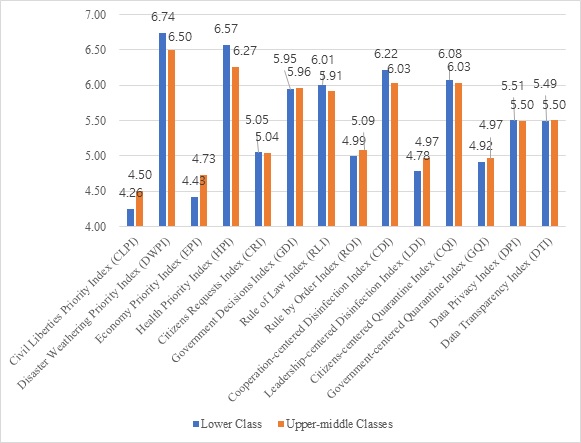
When it comes to
the global trend of individual values, people are prone to value disaster
weathering, social distancing, government decisions, along with rule of law, cooperation-centered
disinfection, and citizens-centered quarantine. The results of the individual
value indexes by different classes are of interest since the lower class’s
individuals are more active in global trend values considering that their index
scores are higher than that of upper-middle classes.
Below figures are bar
graphs of each index of each city. The calculation method is that the score of
upper-middle classes minus that of the lower class, and therefore, if the
result value is negative, it means that the lower class people think more
highly of the corresponding ideology than upper-middle class; whereas if the
result values are positive, it signifies that upper-middle classes citizens are
more emphasizing that thought than the lower class. Let’s see more detailed
information below.
Figure 2: Bar Graph of Global
Citizens’ Civil Liberties Priority Index (CLPI) by Economic Level
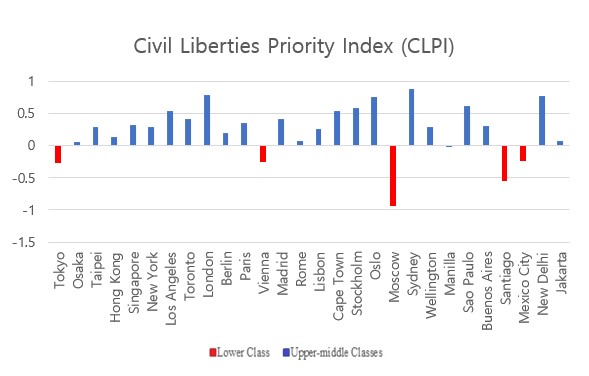
Figure 2 demonstrates
that most upper-middle classes in the world gave higher scores on civil
liberties than the lower class. Meanwhile, the lower class in Tokyo, Vienna,
Moscow, Santiago, and New Delhi gave higher scores on this ideology than
upper-middle class in these cities. To be specific, citizens of the lower class
of Moscow gave 0.93 points higher than those of the upper-middle class on the
issue of civil liberties.
Figure 3: Bar Graph of Global
Citizens’ Economy Priority Index (EPI) by Economic Level
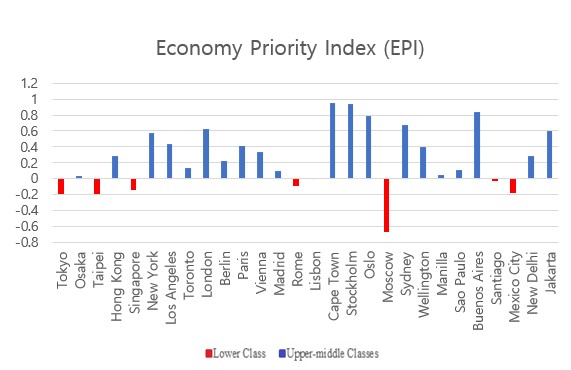
Figure 3
demonstrates that most upper-middle classes in the world gave higher scores on economic
recovery than the lower class. Meanwhile, the lower class in Tokyo, Taipei, Singapore,
Rome, Moscow, Santiago, and Mexico City gave higher scores on this ideology
than upper-middle class in these cities. To be specific, citizens of the lower
class of Moscow gave 0.68 points higher than those of the upper-middle class on
the issue of economic recovery.
Figure 4: Bar Graph of Global
Citizens’ Citizens Request Index (CRI) by Economic Level
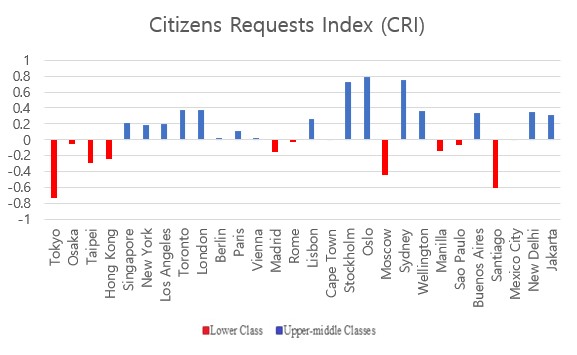
Figure 4
demonstrates that most upper-middle classes in the world gave higher scores on citizens’
requests than the lower class. Meanwhile, the lower class in Tokyo, Osaka,
Taipei, Hong Kong, Madrid, Rome, Moscow, Manila, Sao Paulo, and Santiago gave higher
scores on this ideology than upper-middle class in these cities. To be
specific, citizens of the lower class of Tokyo gave 0.73 points higher than
those of the upper-middle class on the issue of citizens’ requests.
Figure 5: Bar Graph of Global
Citizens’ Rule of Law Index (RLI) by Economic Level
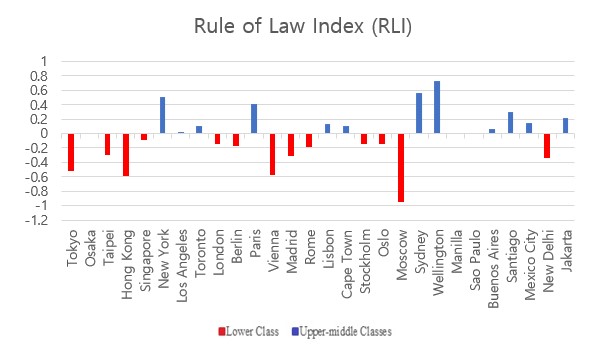
Figure 5
demonstrates that most of the lower class in the world gave higher scores on rule
of law than the upper-middle classes. Meanwhile, upper-middle classes in New
York, Los Angeles, Toronto, Paris, Lisbon, Sydney, Wellington, Buenos Aires,
Santiago, Mexico City, and Jakarta gave higher scores on this ideology than the
lower class in these cities. To be specific, citizens of the lower class of
Moscow gave 0.94 points higher than those of the upper-middle class on the
issue of rule of law.
Figure 6: Bar Graph of Global
Citizens’ Cooperation-centered Disinfection Index (CDI) by Economic Level
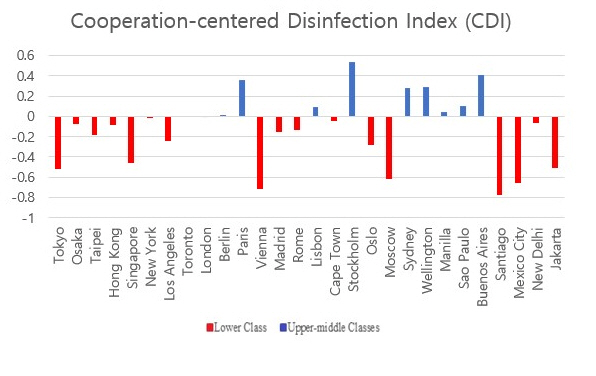
Figure 6
demonstrates that most of the lower class in the world gave higher scores on cooperation-centered
disinfection than the upper-middle classes. So-called cooperation-centered
disinfection lies in citizens’ active trust and cooperation in terms of recovering
from the disaster. Meanwhile, upper-middle classes in Berlin, Paris, Lisbon,
Stockholm, Sydney, Wellington, Manila, Sao Paulo, Buenos Aires gave higher
scores on this ideology than the lower class in these cities. To be specific, citizens
of the lower class of Santiago gave 0.77 points higher than those of the
upper-middle class on the issue of cooperative disinfection.
Figure 7: Bar Graph of Global
Citizens’ Citizens-centered Quarantine Index (CQI) by Economic Level
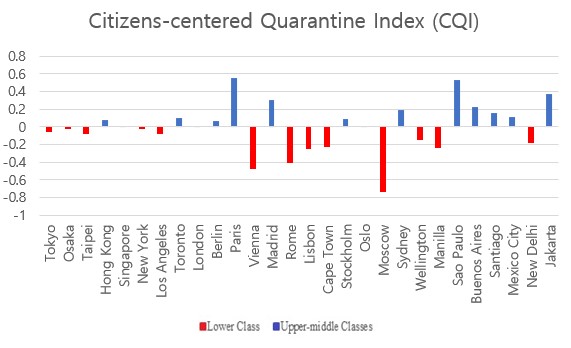
Figure 7
demonstrates that there are no significant differences between the lower and
the upper-middle classes in regard to citizens-centered quarantine. So-called
citizens-centered quarantine means that the citizens are the main actors in the
prevention of an epidemic. The result shows that the lower class of some cities
gave higher scores on citizens-centered quarantine, while the upper-middle
classes of some cities gave higher scores on citizens-centered quarantine. The
difference is slight and trivial in this ideology. However, Moscow shows a huge
gap between the two groups. To be specific, citizens of the lower class of
Moscow gave 0.74 points higher than those of the upper-middle class on the
issue of citizens-centered quarantine.
Figure 8: Bar Graph of Global
Citizens’ Data Privacy Index (DPI) by Economic Level
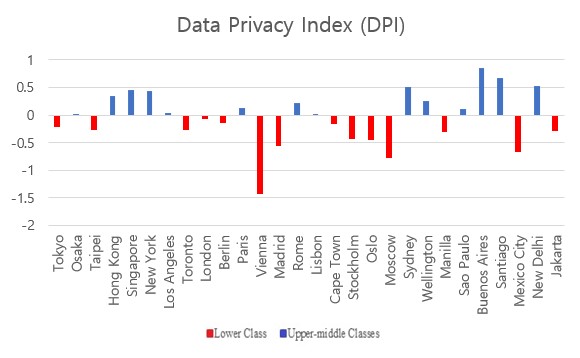
Figure 8
demonstrates that there are no significant differences between the lower and
the upper-middle classes in regard to data privacy. So-called data privacy is,
in contrast to revealing the movement history of infected people in detail,
protecting people’s personal information, and not to treat patients like
enemies. The result shows that the lower class of some cities, such as Tokyo,
Taipei, Toronto, London, Berlin, Vienna, Madrid, Cape Town, Stockholm, Oslo,
Moscow, Manila, Mexico City, and Jakarta, gave higher scores on data privacy,
while the upper-middle classes of some cities, like Osaka, Hong Kong, Singapore,
New York, Los Angeles, Paris, Rome, Lisbon, Sydney, Wellington, Sao Paulo,
Buenos Aires, Santiago, New Delhi, gave higher scores on data privacy. All in
all, the difference between the two groups is slight and trivial in this
ideology. However, Vienna shows a huge gap between the two groups among 28
global cities. To be specific, citizens of the lower class of Vienna gave 1.43
points higher than those of the upper-middle class on the issue of personal
information.
5.
Summaries
and Further Tasks
a.
Data
analysis shows that the thoughts of the lower-class citizens are more aligned
with the individual values of the global trend.
b.
The
upper-middle class gave higher scores on civil liberties, citizens’ requests,
and economic recovery than the lower class. While the lower class gave higher
scores on rule of law, cooperation-centered disinfection.
c.
In
the process of quarantine, the lower class and the upper-middle classes equally
valued who plays the main role and whether privacy is important or not.
d.
The
study is limited to descriptive research, and therefore, a more detailed
explanative investigation is required to further understand the global citizens’
consciousness presented above. Moreover, the study also requires further
quantitative analysis to assure the accuracy of the results. |